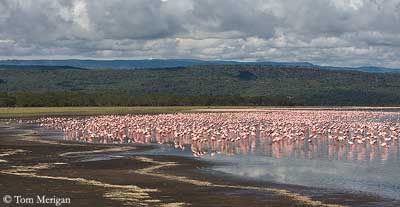
Lesser Flamingo
Phoeniconaias minor
Phoenicopteriforme Order – Phoenicopteridae Family
Fr: Flamant nain
All : Zwergflamingo
Esp : Flamenco Enano
Ital : Fenicottero minore
Nd : Kleine Flamingo
Russe : Малый фламинго
Sd : Mindre flamingo
Photographs by Tom Merigan
His website :
Tom Meriganís Photo Galleries
Photographs by Steve Garvie
His website :
RAINBIRDER Photo galleries
Text by Nicole Bouglouan
Sources:
HANDBOOK OF THE BIRDS OF THE WORLD vol 1 by Josep del Hoyo-Andrew Elliot-Jordi Sargatal - Lynx Edicions - ISBN: 8487334105
BIRDS OF AFRICA SOUTH OF THE SAHARA by Ian Sinclair and Peter Ryan - Princeton University Press Princeton and Oxford - ISBN: 0691118159
BIRDS OF THE MIDDLE EAST by R.F. Porter, S. Christensen, P Schiermacker-Ansen C.Helm - ISBN: 0713670169
Welcome to WhoZoo (Jill Foley)
Wikipedia (Wikipedia, The Free Encyclopedia)
BirdLife International (BirdLife International)

BIOMETRICS:
Length : 80-105 cm
Wingspan : 95-120 cm
Weight : 2200-2700 g
LONGIVITY: Up to 50 years
DESCRIPTION:
Lesser Flamingo is the smallest of the four flamingo’s species.
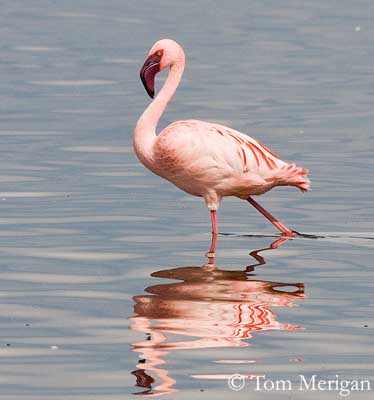
Adult has deep eye and surrounding bare facial skin. It has a rather angry expression. Bill, facial skin and eye look are blackish at a distance. Plumage coloration is usually a brighter deeper pink, and some males have crimson on breast and upperparts.
Lesser flamingo has long deep crimson legs, long neck, a bent deep red bill and a large body. It has the light pink feathers with black feathers on its wings. It has webbed feet. Eyes are yellow-orange, surrounded by a brown ring.
Males are slightly taller than females with a height of 80 cm.
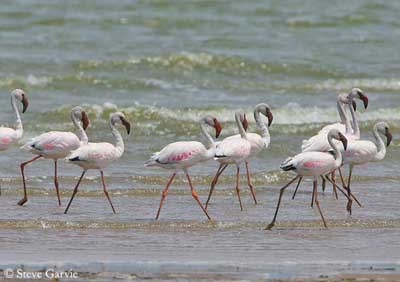
Juvenile is slightly grey, with distinctive darker bill.
Immature is very pale, almost whitish.
VOICE: SOUNDS BY XENO-CANTO
Lesser Flamingo’s flight call is a high pitched “kwirrik”. Feeding or walking birds give a low murmuring “murrrh-murrrh-errh”.
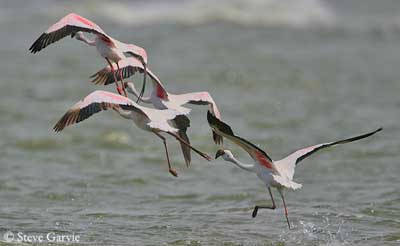
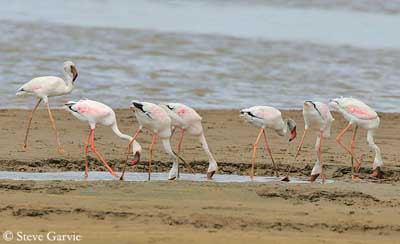
HABITAT:
Lesser Flamingo breeds in brackish or salty lakes and lagoons in S Africa, and highly alkaline lakes in E Africa. Non breeding birds may be found on coastal mudflats, salt works and sewage treatment works where salinities are high.
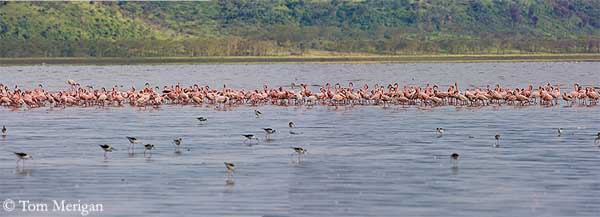
RANGE:
Lesser Flamingo is a nomadic bird. It is found throughout Africa, as well as Spain, India, Pakistan, Afghanistan, Iran, Oman and Yemen.
BEHAVIOUR:
Lesser Flamingo feeds in a typical posture of flamingos, long neck bent over and bill upside down the water. The tongue is pumped to suck in the salty, alkaline water and mud. Filters in the mouth catch microscopic algae in the water.
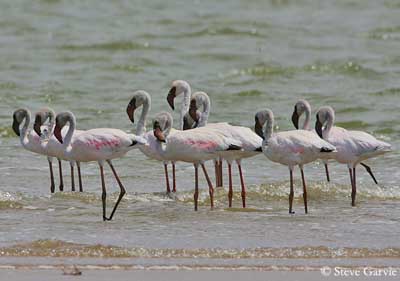
Lesser flamingo has a spectacular courtship display, taking place all the year long. Groups of birds from a few to several hundred gather to march back and forth, all in the same direction. They stand tall with their necks stretched upwards and flap their wings out to flash the colours of their feathers.
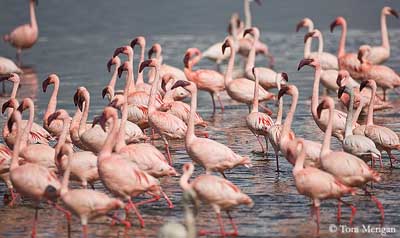
Flamingo’s movements take place at night.
Lesser flamingo has a very poor sense of taste and no sense of smell. Eyesight plays an important role in group activities. Flamingos use various techniques of flashing the back feathers on their wings to communicate. Hearing is also important for communication between adults and between chicks and its parents.
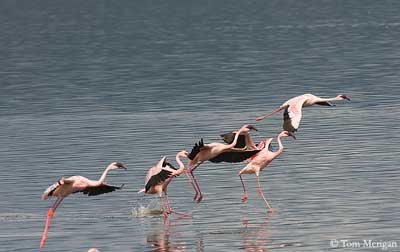
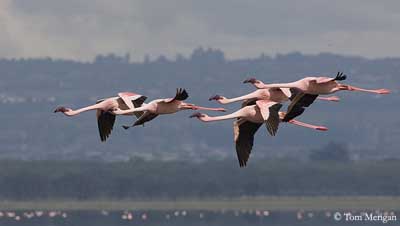
FLIGHT:
Lesser Flamingos fly in large V-shaped formation. They fly at around 60 km per hour, and can travel up to 1500 km.
NIDIFICATION:
Lesser Flamingos breed in colonies of thousands birds. Following the display, Lesser Flamingo pairs up and builds a mud nest, up to 30 cm high to protect it from flooding and to keep it cool.
Female lays a single egg. Incubation lasts about 28 days, by both parents in 24 hours shifts.
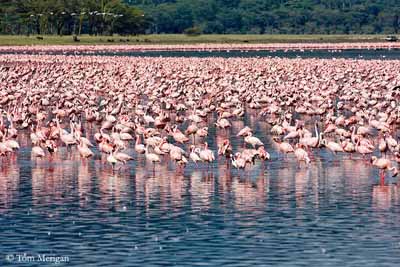
Chick is grey with thick grey legs and a straight bill. Its weight is about 73 to 98 grams. It eats its own shell and is fed by parents with a liquid soup during about two months, until its bill is developed enough to filter food. Each chick must learn to recognize its parent’s call. At 6 days old, the chick joins a “crèche” of thousands of other chicks. There, it runs at one week, gets feathers at four weeks, and flies at 12 weeks.
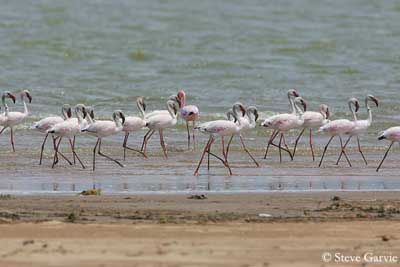
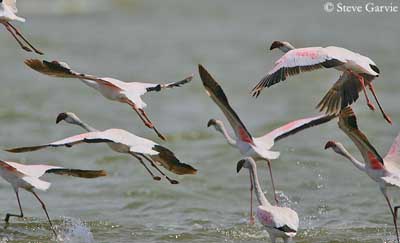
DIET:
Lesser Flamingo sucks in water and mud to catch algae. It feeds on small insects and crustaceans.
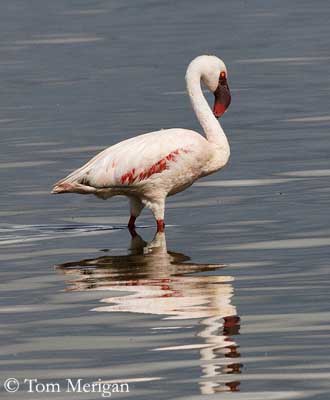
PROTECTION/THREATS/ STATUS:
Lesser Flamingo has some predators such as Marabou Storks, Lapped-faced Vultures, White-headed Vultures, and Egyptian Vultures. But during adulthood, predation by lions, leopards, cheetahs and jackals is common.
Lesser flamingo is vulnerable to water pollution from pesticides, and heavy metals, and human disturbances.
Breeding sites in eastern Africa and southern Africa have no specific protection, but feeding sites in eastern Africa are partially contained in National parks and reserves.